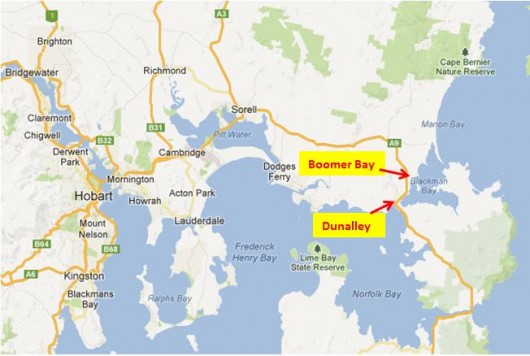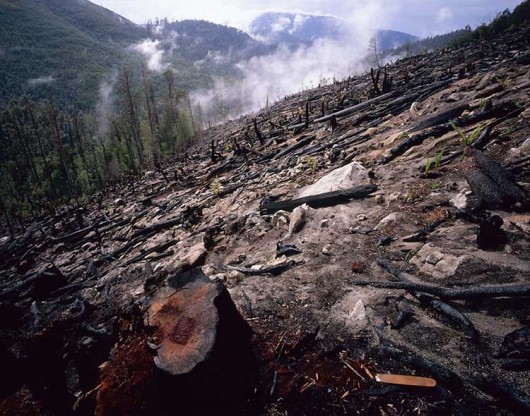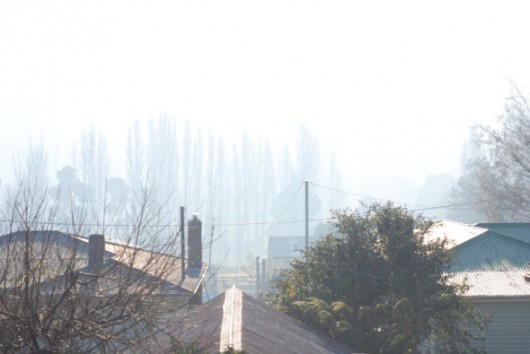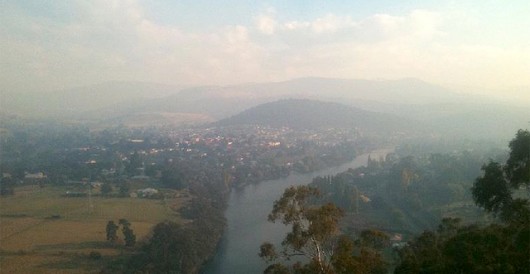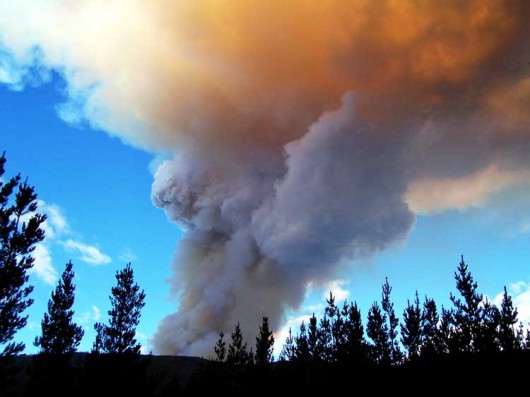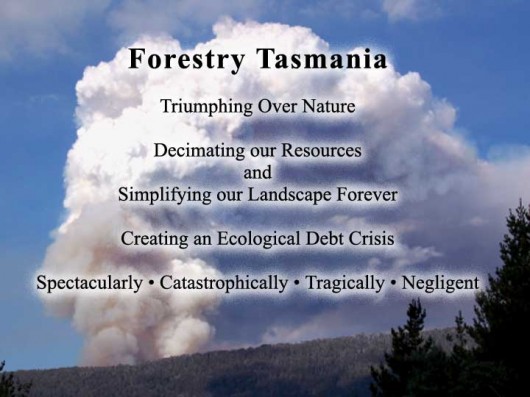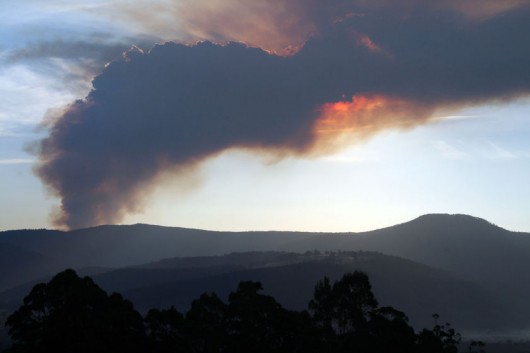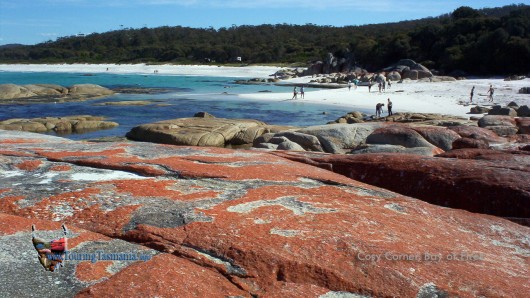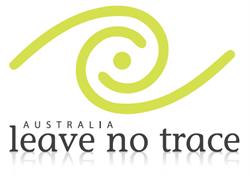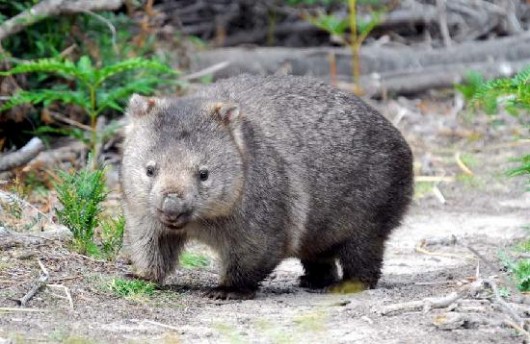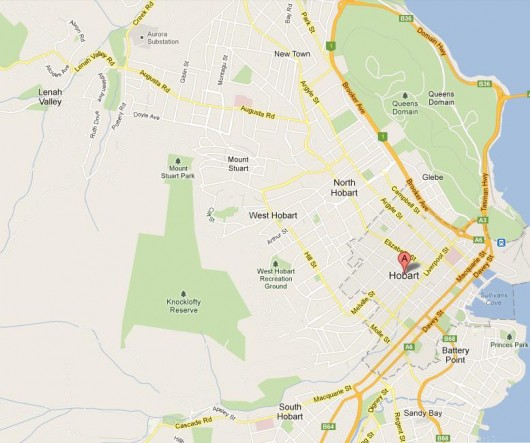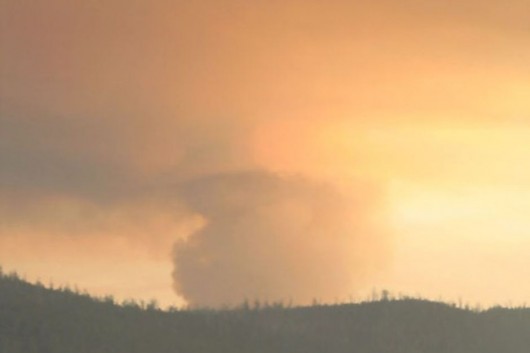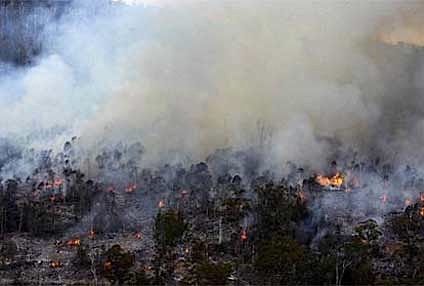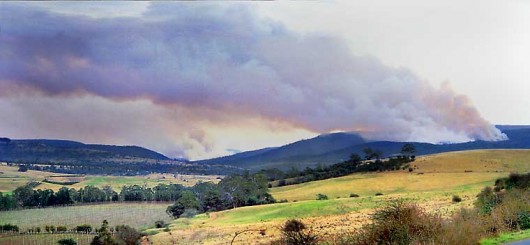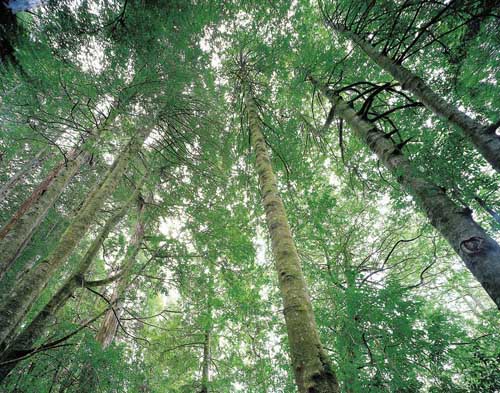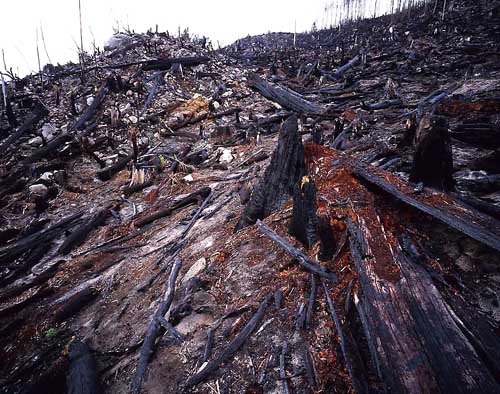Culpable Negligence of Tasmanian Burn Offs
Saturday, January 5th, 2013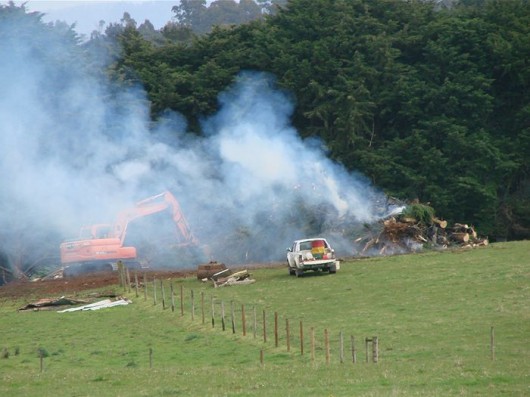 Burn Offs in Tasmania are a Dangerously Reckless Habit
[Source: ^http://www.abc.net.au/rural/tas/content/2012/11/s3636811.htm]
Burn Offs in Tasmania are a Dangerously Reckless Habit
[Source: ^http://www.abc.net.au/rural/tas/content/2012/11/s3636811.htm]
.
It’s another hot summer that Australian state government fire services all brand the ‘bushfire season‘, because inevitably bushfires occur yet still recklessly get out of control.
It’s 2013 and we didn’t have to wait long. Since yesterday (and prior) bushfires have raged across the state.
.
Remembering Hobart’s Black Tuesday
.
Tasmanians lost their bushfire innocence in 1967 when on 7th January 110 separate fire fronts burnt through some 2,640 square kilometres (652,360 acres)(264,000 ha) of land in Southern Tasmania including Hobart within the space of five hours.
It became known to Tasmanians as ‘Black Tuesday‘. Tragically, sixty two people died, another 900 were injured and over seven thousand were made homeless. Property loss was extensive with 1293 homes, and over 1700 other buildings destroyed. The bushfires also destroyed 80 bridges, 4800 sections of power lines, 1500 motor vehicles and over 100 other structures. It was estimated that at least 62,000 farm animals were killed. The total direct economic loss amounted to $40 million in 1967 Australian dollar values.
The bushfire causes were attributed to:
- Dense and tinder dry Eucalypt bushland following an eight month dry spell
- Many flammable properties situated close to and amongst bushland and tall dry grass
- Very hot dry windy weather to 39 °C, yet such weather conditions are not abnormal for Tasmania nor many other regions of Australia during summer. McArthur’s report on the fire noted that ‘very similar conditions have occurred on three or four occasions during the past 70 years’.
- An ineffective fire fighting response including poor communications
- Many victims were disabled in one way or another to enable them to properly respond (Investigative Report by McArthur and Cheney found that most people who died within their homes or within a short distance of their homes were either very old and infirm or suffered from some physical disability; and the homes of approximately half of the people who died whilst escaping the fire did not catch fire and it could be reasoned that they may have had a reasonable chance of safety had they stayed inside their homes).
- Poor and last minute decision making
- The direct cause was the deliberate lighting of burn offs at a time of extreme bushfire risk. Reports into the causes of the fire stated that only 22 of the 110 fires were started accidentally. So 88 ignitions were deliberately lit as reckless burn offs or else being criminal bush arson.
.
The Tragic D.E.A.D. Pattern
.
1967 Black Tuesday wasn’t a ‘Natural Disaster‘. It certainly became a ‘National Emergency‘, but Black Tuesday was a ‘Man-Made Disaster‘. Lightning hadn’t ignited the fires; people had, habitually burning off in summer!
As after all bushfire disasters, and Australia has had more than its fair share, the survivors as victims and those affected mostly tend not want to attribute blame, but invariably the common feeling is that people just want to make sure it doesn’t happen again.
But to make sure it can’t happen again, the causes and contributing factors need to be identified and understood. Problem is that even despite the causes and contributing factors being identified and understood, solutions are not followed through. Bushfire disasters happen time and again and people tragically lose their lives and properties. After the disaster, there’s the government enquiry, the recommendations. Few of the recommendations are implemented and within a few years, it’s back to business as usual. Government complacency fuels apathy and so communities fall vulnerable to the next disaster.
The cynical acronym by those analysing bushfire histories is:
.
DEAD = Disaster > Enquiry > Expenditure > Apathy > Disaster >…
.
This is 2013. It is unacceptable that like motor vehicle deaths, the forces that cause the most horrific and costly tragedies in Australia (i.e. ‘bushfires‘) are treated with such ambivalence, negligence, token resourcing and culpable under-preparedness by Australian governments at all levels. Bushfire Risk Management is clearly lacking. The recklessness at government level, has long learned from bushfire experience and can no longer rely on the excuse of innocence. Governments have a fiduciary duty to protect their dependent communities from avoidable harm. Governments that under-resource bushfire management to adequately do their fire fighting task in known extreme weather conditions are culpable of negligence. Governments allowing burn offs in summer are criminally negligent.
And it’s not about kneejerk scorched earthing of Tasmania into a barren landscape, as the ‘bushphobes‘ like WA Liberal Senator Chris Back would favour. It is about addressing the direct causes of bushfires, namely in Tasmania’s case, the senseless burn offs in summer and on days of heightened bushfire risk. It is about adequately resourcing fire management (serious resourcing) so that ignitions can be quickly detected, responded to and suppressed before they cause disaster.
.
[Source: ‘ Local Knowledge and Gender – Re-evaluating the 1967 Hobart Bushfire fatalities’, Jan 2008, by Katharine Haynes, Amalie Tibbits and Thomas Lowe, (jointly Macquarie University and RMIT), ^http://www.riskfrontiers.com/newsletters/rfnewsV7Issue2_Jan08_web.pdf].
.
.
2013: Fast-forward Two Generations
.
So in 2013, 46 years hence, Tasmanians are not bushfire innocent, but ought to be extremely bushfire risk wary and better prepared. But are they? Is the Tasmanian Fire Service adequately resourced and prepared. Does the Tasmanian Government still adopt an attitude of defeatism – that extreme bushfire conditions are beyond anyone’s control? Is this attitude acceptable to Tasmanian society in 2013?
The weather is similar this time of year. Hobart recorded 41.8C at 4.05pm yesterday. Thirty seven years ago Hobart recorded 40.8C. [Source: ^Hobart Mercury] The vegetation is the same. Still many flammable properties continue to be situated close to and amongst bushland and tall grass, arguably indefensible in the event of a major bushfire threat under extreme bushfire weather conditions.
Isn’t that why the bushfire risk grade of ‘catastrophic‘ is now being used by all Australian fire agencies, including the Tasmanian Fire Service (TFS)?
Pertinent questions for the Tasmanian Government (ultimately responsible for bushfire emergencies in Tasmania) remain however:
- How better prepared and equipped is the Tasmanian Fire Service today to properly detect, respond and suppress bushfires under such extreme weather circumstances?
- How better prepared and equipped are Tasmanian property occupiers to properly recognise and react appropriately to save themselves and their properties in the event of a bushfire under such extreme weather circumstances?
- More concerning is why are burn offs are permitted in summer at all at a time of extreme bushfire risk?
- What do we pay our taxes and rates levies for bushfire emergency services, if when there is a major bushfire emergency the response is invariably: ‘everyone for themselves‘?
.
Just two days ago (3rd January 2013) a total of 14 bushfires had been reported active across Tasmanian on the TFS website, and these were in addition to others that had been reported in previous days that had either been suppressed or were being contained or monitored.
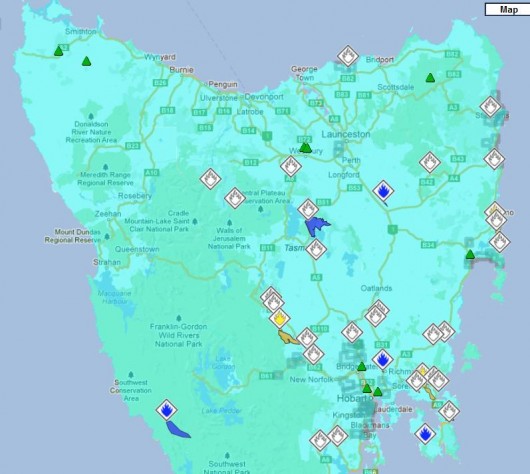 Tasmania – Current Bushfires and Other Incidents as at 20130105
[Source: Tasmanian Fire Service, ^http://www.fire.tas.gov.au/Show?pageId=colGMapBushfires]
Tasmania – Current Bushfires and Other Incidents as at 20130105
[Source: Tasmanian Fire Service, ^http://www.fire.tas.gov.au/Show?pageId=colGMapBushfires]
.
Why so many bushfires across Tasmania?
.
The fires all seem to be distributed near rural properties so are rural folk continuing to light ‘burn offs‘ when temperatures are in the high 30 Celsius range and beyond? Why are Fire Permits being issued this time of year when the risk of bushfire is considerably heightened? Don’t people learn?
Or are holiday makers lighting campfires and not properly extinguishing them? Surely there are no deliberate hazard reduction burns this time of year?
Or is there a spate of bush arsonists starting these fires?
The public isn’t informed about the causes of most bushfires and the causes are not reported on the official Tasmanian Government website. At the time of the bushfires, while admittedly the exact cause(s) may simply not be known to authorities, the problem is that subsequently the causes are rarely reported anyway. So all these bushfires start yet the public is kept in the dark about the causes aside from tacit reporting of the status of the fire fighting effort.
Is it for reasons of embarrassment or culpability?
.
Dec 2006: The Scamander Bushfire
.
In December 2006, a bushfire destroyed eighteen houses and a restaurant in the small seaside village of Scamander on Tasmania’s north east coast. The cause is not readily published, but was it yet another escaped burn off?
<<On December 12th, 2006 Scamander and surrounds (were) enveloped by a bushfire coming from the south-west in the area of St. Marys. The township had little warning and really was unprepared in the extreme. If any luck existed for Scamander township was the fact that it occurred in late afternoon. Thus as evening approached the windy conditions which had been creating inferno like conditions, where it looked like nothing would stop it, lessened. Not to belittle this event but people further south of Scamander in the area of Four Mile Creek ‘took a copping’ the next day with winds changing to northerlies.>>
[Source: ^http://eurekafarm.com.au/bloghh/scamander-bushfire-2006].
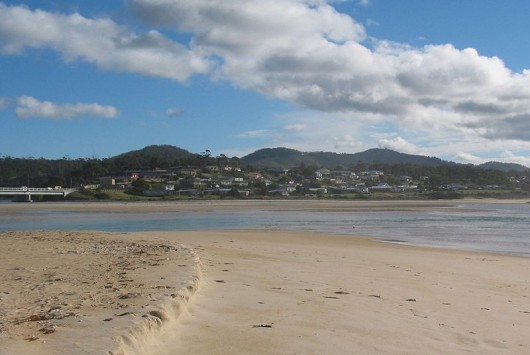 Scamander, a loss of 18 houses and a restaurant is considerable for such a small community
Seven years hence, has the community recovered?
Scamander, a loss of 18 houses and a restaurant is considerable for such a small community
Seven years hence, has the community recovered?
.
<<The most destructive Tasmanian bushfire in years menaced the island’s east coast last night, challenging fire authorities’ message that defended property would survive.
Heartbroken owners stood amid the ruins of houses and businesses at the coastal town of Scamander, where 18 properties were destroyed or damaged. But many more people in the same bushy back streets survived the flames, to stand dazed amid their unburned assets.
As the fires raged on into the evening through forests south around the town of St Marys, firefighters and home owners stemmed further losses despite the magnitude of a 20-kilometre front.
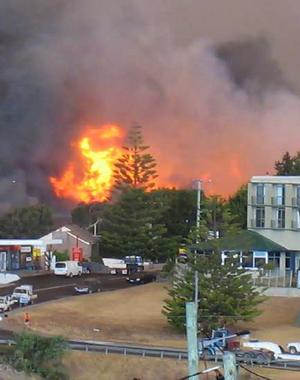 The fire impacting Scamander
The fire impacting Scamander
.
“I have every confidence in the advice we have been giving: stay and defend, or leave early,” Tasmania’s chief fire officer, John Gledhill, said.
About one in 15 of the bush block dwellings in southern Scamander burned, and many of those were defendable, according to Tasmanian Fire Service acting district officer Ian McLachlan. “We feel some of the structures destroyed may have been saved, had people stayed,” Mr McLachlan said.
He stood amid the ruins of a restaurant and art gallery where the operators fled from what was said to be a rapidly moving wall of flame. One man was injured in the fire. He was flown to Royal Hobart Hospital where he was in a satisfactory condition suffering from burns and smoke inhalation, a hospital spokeswoman said.
The mayor of the local Break O’ Day Council, Robert Legge, said emergency services had managed to cope with the terrifying devastation.>>
.
[Source: ‘Scamander faces regrets and ruins’, 20061213, by Andrew Darby, St Helens, The Age newspaper, ^http://www.theage.com.au/news/national/scamander-faces-regrets-and-ruins/2006/12/12/1165685681155.html].
Feb 2012: The Meadowbank Bushfire
.
The Meadowbank Bushfire started on Saturday 25th Feb (late summer), reportedly by “accident” at the Meadowbank Dam east of Karanja near Maydena (Central Highlands).
It burnt out over 5000 ha and two days later was still officially ‘out of control’. Was it too an escaped burn off by pastoralists or foresters or perhaps another log pile burn by industrial logger, Norse Skog? “Accidental?”
<<Sixteen units with about 50 personnel have been deployed to the fire along with heavy machinery and helicopters for water-bombing. The fire is burning in open grassland and light bush and there is no immediate risk to communities. However, hot conditions are expected later today with a fire danger rating of very high. The bushfire is currently not controlled. Fire under forecasted conditions may be difficult to control.
The fire has been investigated by Tasmanian Fire Service and the cause was found to be accidental. Reported road closures are: Rockmount Road, Meadowbank Dam Road and Meadowbank Road.>>
[Source; ‘TFS statement on Meadowbank fire’, 20120226, by Jarrod Watt, ^http://blogs.abc.net.au/tasmania/2012/02/tfs-statement-on-meadowbank-fire-sunday-11140am.html].
.
Feb 2012: The Powranna Road Bushfire
.
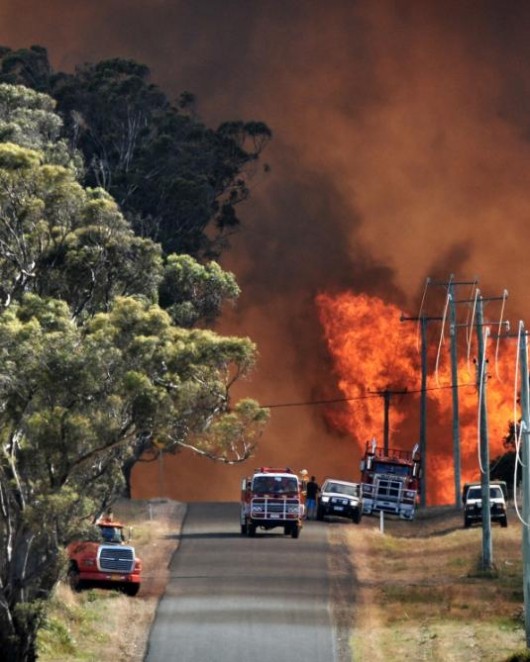 Powranna Road, south of Launceston
Powranna Road, south of Launceston
.
<<A fire that raged near Symmons Plains (south of Launceston) yesterday burnt through 530 hectares of private land – more than three times larger than was originally thought. The fire is now contained but fire crews will remain on alert as the North endures another high fire danger day today.
The fire started at 3.30pm yesterday and quickly spread to Powranna Road, fanned by strong winds and 30 degree temperatures.
A Tasmania Fire Service spokeswoman said cooler conditions overnight helped firefighters establish containment lines around the blaze. Earthmoving equipment was being used to construct fire breaks and fire crews remained on site to monitor the fire, which started at Powranna Road. Powranna Road remains closed but the spokeswoman said the fire was no longer a threat to lives or property.
“If it stays like this there will be no concerns at all,” she said. “It just depends on the weather.”>>
[Ed. Famous last words]
.
[Source: Powranna fire under control’, by Calla Wahlquist, Polkice Reporter, 20120226, The Examiner (newspaper) Launceston, ^http://www.examiner.com.au/story/431212/powranna-fire-under-control/].
How caused? No answers. Why? Another burn off in summer escaped again?
.
Feb 2013: Official TFS Media Releases
.
Wed 2 Jan 2013: ‘Severe Fire Weather Expected’
- The weather forecast over the next few days will see temperatures reach into the thirties together with dry winds and low humidity’s. This will mean fires burning will be extremely difficult to control as fire danger ratings increase to Very High and Severe across much of the State.
- Tasmania Fire Service have ceased issuing fire permits in the Northern and Southern Regions as a result of the forecasted weather conditions, and it is highly likely a Total Fire Ban will be declared for Thursday & Friday although this is yet to be confirmed.
- TFS Chief Officer Mike Brown said “now is not the time to start any new fires and members of the public need to make sure any fires lit on their properties over the last week are completely extinguished. This means making sure fires that have been extinguished are cool to touch and checking the fire is not burning in the root systems of plants.
- Special care must be taken when using machinery that emits sparks, such as mowers, slashers, grinders and other cutting tools, as this type of activity have the potential to start fires”.
- Campers, bushwalkers, and anyone heading into rural areas over the next week need to be vigilant. Campers should refrain from lighting fires over the next 48 hours and all fires MUST be extinguished fully and cold to touch before leaving them unattended.
.
Later that day:
- A Total Fire Ban has been declared for the Southern Region of Tasmania from midnight tonight, Wednesday 2 January 2013 until midnight Thursday 3 January 2013.
This includes the municipalities of:
Brighton
Central Highlands
Clarence
Derwent Valley
Glamorgan/Spring Bay
Glenorchy
Hobart
Huon Valley
Kingborough
Sorell
Southern Midlands
Tasman
- Chief Officer Mike Brown said: “Due to tomorrow’s forecast for hot conditions, the Tasmania Fire Service has banned all fires out of doors in the Southern Region. There are significant penalties that can be imposed on anyone not adhering to the Total Fire Ban restrictions”.
.
Thu 3 Jan 2013: ‘Total Fire Ban Statewide’
- Extreme Fire Weather Leads to State-wide Total Fire Ban from Midnight Thursday 03/01/2013 until Midnight Friday 04/01/2013
- “Forecasted temperatures in the high 30‟s and strong dry winds across Tasmania have led to the declaration of a State-wide Total Fire Ban commencing midnight tonight”. The TFS Chief Officer Mike Brown announced today.
- “Conditions forecast for tomorrow are the worst since the 2006/07 season where large fires impacted in the States North East, Hobart’s eastern shore, Mt Nelson and Epping Forest. We have additional strike team crews, heavy machinery and aircraft at ready to respond but under the Extreme conditions firefighting will be very difficult”.
- “With the conditions we are expecting the safest option for people who are not prepared is to simply leave early and go to a friend or relatives place away from bushland areas. Those choosing to stay must remain vigilant about the conditions around them, review and practice their Bushfire Survival Plan and be ready to respond to any fire that maybe in their vicinity. A plan to „wait and see‟ and leave late is one of the most dangerous options” Mr Brown said.
- All Tasmanians are asked to actively keep aware of the developing fire situation by monitoring local media and the TFS website www.fire.tas.gov.au.
.
Feb 2013: Three Major Bushfires across Tasmania
.
Two days ago (Thursday, 3rd January 2013) according to the Tasmanian Government’s official website of its Tasmanian Fire Service, three particular ‘Vegetation Fires’ started, separately near:
-
-
- Bicheno Bushfire (East Coast)
- Lake Repulse Bushfire (Central Highlands)
- Forcett Bushfire (South East)
- Bicheno Bushfire (East Coast)
-
.
These three fires have become Major Fires involving significant spread and property loss. At the early morning of Saturday 5th January the respective areas burned were Bicheno (2100 ha), Lake Repulse (450 ha) and Forcett (“not reported”). The television coverage of the Forcett Bushfire suggests that many thousands of hectares of vegetation have already been burned.
 Tasmania – Current Bushfires and Other Incidents (estract) as at 20130105
[Source: Tasmanian Fire Service, ^http://www.fire.tas.gov.au/Show?pageId=colCurrentBushfires&filter=all]
Tasmania – Current Bushfires and Other Incidents (estract) as at 20130105
[Source: Tasmanian Fire Service, ^http://www.fire.tas.gov.au/Show?pageId=colCurrentBushfires&filter=all]
.
‘Thousand flee fire storms’
[Source: ‘Thousand flee fire storms’, 20130105, by Anne Mather, Dave Killick and Zara Dawtrey, The Mercury (newspaper) Hobart, with AAP, ^http://www.themercury.com.au/article/2013/01/05/369692_tasmania-news.html].
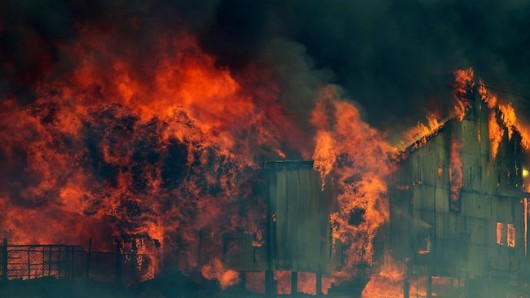 Forcett Bushfire – impacting the coastal village of Dunalley – 65 properties razed
Forcett Bushfire – impacting the coastal village of Dunalley – 65 properties razed
.
<<Homes have been destroyed and police are investigating reports of at least one death following the devastating bushfires that raged in Tasmania yesterday.
On a day of record heat and catastrophic bushfire conditions, up to 40 bushfires blazed across the state — destroying more than 80 properties and leaving hundreds of people cut off from their homes as they took refuge in shelters last night.
The hardest-hit community Dunalley, in the south-east, where 65 properties were lost.
Police are investigating a report that a man died as he fought to protect his Dunalley home. (Ed: Subsequently checked and confirmed 20130110 as untrue)
Police said 15 properties were lost at nearby Boomer Bay, where about 50 people stranded at the beach were being evacuated by boat.
A number of properties were also destroyed at Connelly’s Marsh, west of Dunalley.
Fire raged out of control in Carlton River last night, threatening the popular coastal community of Dodges Ferry.
Just before 11pm, residents of Dodges Ferry were warned it was too dangerous to leave and advised to take shelter at the local primary school only if the path was clear.
It was also too late to leave Primose Sands, Connelly’s Marsh and Susans Bay because Carlton River Rd was impassable and not safe.
The second biggest fire raged out of control at Lake Repulse, in the Upper Derwent Valley affecting communities including Broad River, Jones River and Ellendale.
 Lake Repulse Bushfire, Friday 20130104
Lake Repulse Bushfire, Friday 20130104
.
And a blaze near Bicheno, on the East Coast, destroyed at least one property.
A large grass fire at Epping Forest in the state’s North was also causing concern last night.
Hundreds of evacuated and homeless residents were seeking refuge in emergency shelters. The most crowded catered for 600 people at the Nubeena District High School.
Another group of people is sheltering at the Dunalley Hotel.
About 40 people were taking shelter at Sorell refuge last night and a further 40 at New Norfolk.
Bushfire conditions reached “catastrophic” yesterday, with temperatures soaring to ajl record 41.8C in Hobart. Acting Premier Bryan Green said the day was “devastating”.
He said an emergency relief fund had been set up to which would provide $750 to people to help with their initial displacement.
An emergency crew of police, ambulance and fire officers flew into Dunalley last night to investigate the reported death.
Acting Police Commissioner Scott Tilyard said conditions were so severe that it would be difficult to confirm the report until either later today or early tomorrow.
He said: “We can’t rule out that there has been a loss of life, potentially one but at this stage there could be (others).”
He said the reported death came from a fire crew at Dunalley, who saw the man defending his home.
Tasmania Fire Service Chief Officer Mike Brown said 100 fire crews had been fighting fires around the state.
He said the fire at Lake Repulse appeared to have been started by an abandoned camp fire.
Other fires on the Freycinet Peninsula had been started by lightning, while the cause of the fire that swept through Dunalley was unknown.
Mr Brown said the Dunalley fire had started on Thursday at Forcett.
The fire had isolated the Tasman Peninsula as police set up a road block on the Arthur Highway.
Last night, police vessels were ferrying fuel, generators, medical supplies and other items to Dunalley and to the refuge centres at Nubeena.
Police were also working with Telstra to transport generators and other equipment to start restoration of communication where possible.
There were fears Eaglehawk Neck could be damaged by ember attack from the Dunalley fire but it was hoped conditions would ease today.
However, Mr Brown warned an expected southerly change could also spread the danger.
“As we get the change, the flank of the fire could become the front of the fire,” he said.
The Bicheno fire led to road closures at Friendly Beaches Rd, Courland Bay Rd, Tar Hill Fire Trail and Harvey’s Farm Rd.
Butlers Point campers were evacuated late yesterday, while Courland Bay shack owners were told to implement their bushfire protection plan.
Emergency alert status remained in place last night for the Forcett and Lake Repulse blazes, with residents told not to return to their homes until the danger passes.
Fires are also burning at Nubeena, Four Mile Creek, Steppes and Whitemark.>>
.
‘Man feared dead, at least 80 properties lost in Tasmanian bushfires’
[Source: ‘Man feared dead, at least 80 properties lost in Tasmanian bushfires’, 20130105, by Andrew Darby, Nick Ralston, Sydney Morning Herald, ^http://www.smh.com.au/environment/weather/man-feared-dead-at-least-80-properties-lost-in-tasmanian-bushfires-20130104-2c9c4.html].
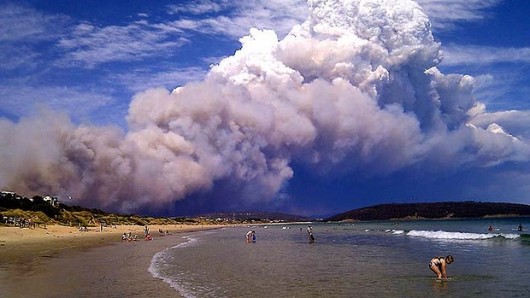 Forcett Bushfire
(Photo credit Sirocco South)
Forcett Bushfire
(Photo credit Sirocco South)
<<At least 80 homes have been lost and one man is feared killed by a bushfire that swept down onto the Tasmanian town of Dunalley, less than 60 kilometres from Hobart, in catastrophic conditions. (Ed: Subsequently the feared death was confirmed 20130110 as untrue)
The bushfire sent hundreds fleeing and was on Friday night still burning down the Tasman Peninsula, taking more properties as it went.
The Tasmania Fire Service acting district officer, Andrew McGuinness, said people should prepare for the worst. ”We’ve lost a lot of property down there.”
A fire at Bicheno burns out of control just 2km a residential town in Tasmania.
(A) local resident, was last seen by a fire crew attempting to save his house as they were forced to shelter in their vehicle when the fire burnt over them, the acting Police Commissioner, Scott Tilyard, said.
Police crews were checking the smouldering town, which is believed to have lost about 65 properties, including many of its houses, as well as shops and the local primary school.
A few kilometres away at the beachside town of Boomer Bay, another 15 properties were gone, Mr Tilyard said.
Many people were forced to shelter on beaches and in shallow water near Boomer Bay, with some evacuated by small boat owners and the police.
Meanwhile, west of Hobart in the Derwent Valley, a separate fire was threatening more houses at Ellendale and Karanja.
Tasmania suffered its most severe fire day in years, with a record 41.8 degrees in Hobart, the highest temperature since 1881. Higher temperatures were observed ahead of the fire front in Dunalley.
Tasmania’s chief fire officer, Mike Brown, said conditions reached the catastrophic level several times during the afternoon, and 100 crews were battling about 25 fires in the state.
The Dunalley fire began on Thursday in bushland about 20 kilometres to the north-west of the town, and swept out of containment lines on Friday afternoon fanned by strong winds.
It was burning to the sea at several points, and had taken properties at Connelly’s Marsh and Murdunna, local reports said.
A bushfire smoke plume visible from Park Beach in Forcett, south-east of Hobart, Tasmania.
A fire at Forcett, 30km from Hobart, sends smoke over Park Beach. At nearby Carlton River residents were being told to evacuate. Photo: Twitter/SiroccoSouth
The acting Premier, Bryan Green, said the government was preparing emergency accommodation, with a report that 600 people were sheltering at one refuge.
”This has been an extraordinary day,” Mr Green said…>>
.
‘Conditions cool as fires devastate Tasmania‘
[Source: ‘Conditions cool as fires devastate Tasmania’, ABC News, 20120105, ^http://www.abc.net.au/news/2013-01-05/conditions-cool-as-fires-devastate-tasmania/4453532?section=tas].
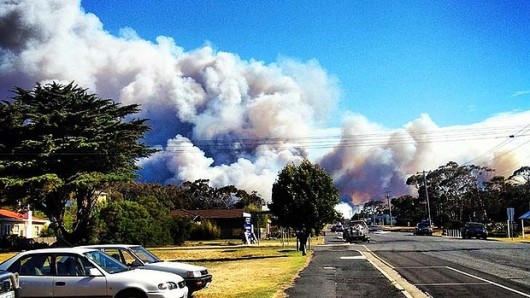 Smoke climbs from a fire burning just kilometres from homes at Bicheno, Tasmania’s east coast
Photo: Hannah Woolley
Smoke climbs from a fire burning just kilometres from homes at Bicheno, Tasmania’s east coast
Photo: Hannah Woolley
<<At least 80 properties have been destroyed and there are fears one person has been killed as out of control bushfires rage in parts of Tasmania.
Hundreds of residents have been forced to take shelter on beaches and in boats on the water overnight in the state’s south-east as fire crews worked through the night to control the blazes.
On the Tasman Peninsular, a massive sea rescue operation has moved more than 1,000 people trapped by fire to safety, 50 kilometres away to Hobart.
Rescue volunteers in boats, plucked people trapped by the fires off beaches overnight, with more sea rescues planned this morning. Tasmania’s Fire Service (TFS) no longer has any active emergency warnings, but several fires in the state’s centre and south-east are still burning out of control, forcing evacuations and the closure of many roads.
The TFS advise there is a watch and act alert for a large bushfire burning out of control along the Tasman Highway, near Bicheno, which may affect the communities of Butlers Point, Courland Bay, Friendly Beaches and Harvey’s Farm Road around 9:00am (AEDT).
In the state’s south-east, residents near Eaglehawk Neck should maintain their bushfire plans as a large bushfire continues to burn at White Hills Road, Forcett, Copping and Dunalley.
The TFS says residents at Bream Creek, Copping and Boomer Bay should evacuate to the safer place in their bushfire plans, or to the Falls Festival site at Marion Bay, but only if the path is clear.
An out of control fire at Lake Repulse is also continuing to impact Ellendale and Karanja in the Upper Derwent Valley.>>
.
[Ed: Does this have the same cause as the Meadowbank Bushfire around this time last year]
.
<<A watch and act alert is active for the area and residents should maintain their bushfire plans.
The Lake Repulse fire is expected to impact the communities of Lawrenny and Hamilton around 6:00am (AEDT).
There are still around 40 fires burning across Tasmania, with crews still monitoring blazes at Epping Forest, Nubeena and Southwest.
.
Homes destroyed
A triage team has now reached one of the worst hit towns, Dunalley, where at least 65 properties were destroyed.
Police say there have been no confirmed reports of death or injuries there at this stage, however a team will be investigating reports a fire crew was unable to reach a man who was defending his home when the fire passed over.
Acting Police Commissioner Scott Tilyard says a crew at Dunalley was trapped when the bushfire passed.
“They had to take shelter in their vehicle as the fire burned over their vehicle and they were, from that location as I understand it, able to see a gentlemen who was trying to protect his property and they couldn’t get to him, it was too unsafe,” he said.
Dunalley resident Tony Young says he realised the town was in danger when he noticed clouds of smoke and a helicopter.
“I’d no sooner said that than the embers came straight into the garage where I was standing and ignited the ceiling in the shed and just engulfed it,” he said. “So all I could do was drive the car out of the shed, drive across the other side of the road and stand back and look at the whole place just being engulfed in flames, just like a movie.”
There are reports at least 15 properties have been destroyed at Boomer Bay, near Dunalley.
In the Upper Derwent Valley, another three homes as well as farming equipment and livestock have been destroyed.>>
.
Ed. It is tragic that in 2013, Australian Governments still allow bushfires to kill and maim people and to destroy property and lives – human, livestock and untold numbers of wildlife and important ecology.
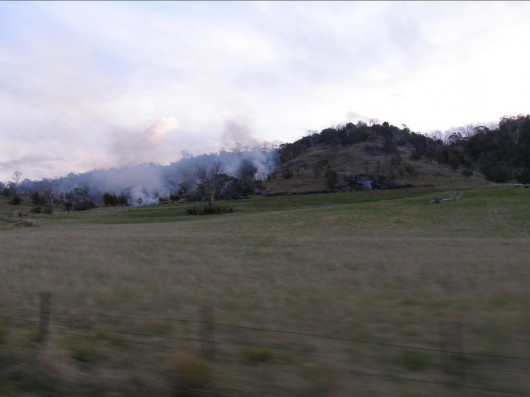 Another Tasmanian Burn Off, unsupervised, happily burning away…
Another Tasmanian Burn Off, unsupervised, happily burning away…off the west side of the Tasman Highway a few kilometres south of Swansea [Photo by Editor late afternoon, 20110926, photo free in public domain]
.
.
.
Footnote
.
‘Australia: Government culpability in 2009 Victorian bushfires’
By Margaret Rees and Richard Phillips
17 May 2010
[Source: ^http://wsws.org/en/articles/2010/05/bush-m17.html]
.
<<It is almost 18 months since catastrophic bushfires, the worst in Australian history, swept through the state of Victoria on February 7, 2009, killing 173 people, including 23 children, and incinerating 300,000 hectares and 200 homes. Over the past five weeks the ongoing royal commission into the catastrophe has focused on two key issues—the part played by senior emergency services personnel on “Black Saturday” and the role of the state’s “stay or go” policy in the high death toll. In both areas, evidence has emerged of government negligence and culpability.
Testimony and evidence heard by the royal commission has revealed an effective breakdown within Victoria’s senior emergency services leadership on the day of the bushfires.
Three of the state’s most senior police officers and Minister for Police and Emergency Services Bob Cameron were absent from the Integrated Emergency Co-ordination Centre (IECC) during key periods on Black Saturday. The uncoordinated and chaotic division of responsibilities and functions of senior police and emergency services leadership points to the negligence of the state Labor government of Premier John Brumby. It made no serious attempt to establish clear lines of command and communication inside the IECC prior to the devastating fires.
Most of those who died on February 7, 2009 perished in their homes after receiving no warnings from emergency authorities about the approaching fires. Prior to Black Saturday there was neither a national uniform bushfire warning system nor consistent national standards for message warnings. Triple-0 emergency services were grossly understaffed, resulting in more than 10,000 calls being left unanswered on the day of the bushfires, along with 80 percent of calls to the state’s bushfire information line. Householders in many fire risk areas had to contact the local ABC radio service for emergency warnings and updates on the fires. Others were totally isolated—before and after the fires.
While all this was occurring Christine Nixon, then the Victorian police chief and head of emergency services, left the IECC at 6 pm to have dinner with friends, despite knowing that people had been killed by major fires which were engulfing communities. Nixon also kept a string of personal appointments earlier that day. She initially told the commission that she had been in constant contact with other senior officials, but subsequent testimony revealed that she had not spoken with her deputy officers or anybody else at the IECC between 6 pm and 9 pm.
Emergency Services Commissioner Bruce Esplin told the commission that Nixon was “in charge” on Black Saturday but didn’t know why she was not at the IECC on Saturday night.
Deputy Police Commissioner Kieran Walshe claimed that he had been in regular contact with Nixon throughout the day, but later admitted that he hadn’t spoken to the police commissioner until 9.45 pm that night. Neither Walshe nor assistant commissioner Stephen Fontana, both delegated by Nixon, was at the IECC when Victorian Police and Emergency Services Minister John Cameron finally arrived there just before 9 pm on Saturday night. Cameron testified at the royal commission on May 7, the first state government minister to do so since hearings began in early 2009. He said that he had spent much of Black Saturday protecting his own rural property.
Questioned by counsel assisting the commission, Jack Rush QC, Cameron was unable to explain exactly who was in charge of the state’s emergency response to the fires. He was unaware that under Victorian law the minister is the coordinator-in-chief of emergency management and the chief commissioner of police his deputy.
Rush asked Cameron whether there was “any structure in place that you understood to be in place where Ms Nixon, Ms Walshe, or Mr Fontana would be on duty in an active position to make active decisions between 6 pm and 9 pm.” The minister answered “no”.
These latest revelations follow the testimony last year of Country Fire Authority (CFA) chief Russell Rees who was at the control centre on Black Saturday. Rees did not become actively involved in operational issues at the centre, and was unaware of maps that had been produced by Melbourne University forestry and fire modelling scientist Dr Kevin Tolhurst and two other mapping experts working at the IECC on the day of the fires. The maps predicted the paths of the Kilmore East and Murrundindi fires, which killed over 100 people. Rees did not find out about the maps or act on their predictions because, he told the commission, no one had a statutory responsibility to warn the threatened towns.
Rees had been previously praised by Victorian premier John Brumby and reappointed as CFA chief in 2009 for another two years, but resigned his position late last month, just before making a final appearance at the commission.
The disorganised and complacent responses of Cameron, Nixon and Rees to the Black Saturday fires did not merely reflect individual negligence. The absence of any functioning emergency response leadership was another expression of the failure of successive Labor and Liberal governments to establish a planned, coordinated, and properly resourced series of bushfire emergency preparation and response measures.
Victoria is one the most bushfire-prone regions in the world, but there was no effective collective evacuation plan, funding for adequate road and transport systems was grossly inadequate, and communications technology and other emergency infrastructure proved absent or ineffective. All this was the direct outcome of the pro-market program developed over the last two decades; funding for social infrastructure and public services has been gutted across the board, while privatisation and the imposition of the “user pays” principle have seen almost every aspect of social life opened up to the dictates of the profit system.
The official “stay or go” emergency bushfire policy developed seamlessly in this context. Under the policy, individuals are left to determine their own response to approaching bushfires: they are supposed to either evacuate the area well before the fires arrive, or stay and execute their own fire-fighting plans. “Stay or go” effectively absolved government authorities of any responsibility for evacuating threatened residents.
Evidence presented to the commission by emergency response experts over the past month has exposed the tragic consequences of this policy.
Professor John Handmer, a disaster management expert from RMIT’s Centre for Risk and Community Safety, has made a detailed investigation into the Black Saturday fatalities. He told the hearing that 58 percent of those who died had not made any preparations to defend their homes. But more than 20 percent of those killed had followed CFA policy and were “well prepared”. The definition of “well prepared”, however, consisted of having a water supply and mops and buckets to use as firefighting equipment. Handmer admitted that the policy relied on ordinary citizens being mentally and physically equipped to handle situations that even experienced firefighters may not be able to deal with.
Harvard University emergency management specialist, Professor Dutch Leonard, told the royal commission that “stay or go” could not be judged on what inexperienced citizens “should do” and was an “invitation to a potential disaster”. He said that he taught his students at Harvard that hoping people might do something “does not amount to a policy”.
University of Utah wildfire evacuation expert Tom Cova testified that “stay or go” had “multiple flaws”, and that in most cases evacuation was “far superior” to people staying in threatened homes. Cova said that residents who lacked experience and adequate information should not be placed in a position of determining whether to stay or go.
Professor Paul ‘t Hart from the Australian National University told the hearing that the Victorian government should introduce mandatory evacuations as part of its response to bushfires and similar emergencies. He said while there would always be lingering doubts about whether authorities had over-reacted if people were ordered out pre-emptively, this was far better than if evacuations did not take place and scores were killed.
Despite such testimony the Labor government continues to strenuously defend “stay or go”, albeit with minor modifications. Brumby has insisted, moreover, that he has no intention of establishing emergency evacuation systems. The premier claimed in the immediate aftermath of Black Saturday that this was “logistically impossible”. Demands for placing electricity powerlines underground in national parks and other bushland areas have been rejected out of hand by the government as “too expensive”, as have calls for significant increases in the number of fire-fighting personnel and the construction of genuine fire safety refuges to protect people in fire-prone areas.
Since Black Saturday, only 45 additional project fire-fighters have been hired while a recently introduced national bushfire-warning system that includes “code red (catastrophic)” warnings has been denounced by bushfire scientists as a knee jerk response, with little scientific input.
Last month it was also revealed that the CFA’s emergency paging system for firefighters was substandard and only running at 20 percent capacity. This was due to the state government’s refusal to fund the construction of transmitters necessary to eliminate black spots across the state. The result was a huge backlog on Black Saturday, with many messages delivered hours late, in some cases 12 hours after they were sent.
The commission is due to release its final report on July 31. No indication has been given that the state premier will be summoned to give evidence about the state government’s catastrophic policies. Whatever the final recommendations, the essential issue raised by the bushfire disaster—the incompatibility of the profit system with the provision of the emergency services and social infrastructure necessary to prevent needless loss of life—will remain unaddressed. >>
.
.
.
‘Class action launched by Australian bushfire survivors against SP AusNet’
Wednesday, February 18, 2009
[Source: ^http://en.wikinews.org/wiki/Class_action_launched_by_Australian_bushfire_survivors_against_SP_AusNet].
<<The largest class action in Victorian history was commenced at the Supreme Court of Victoria on Friday the 13th by Slidders Lawyers against electricity distribution company SP AusNet and the Brumby Government in relation to the Kilmore East fire that became part of the Kinglake complex.
Because of the lawsuit, SP AusNet SPN.AX’s shares on Monday have dropped more than 13.36 per cent or 14.5 cents, to an intra-day low of 94 cents, was at 98.5 cents at 10:38 a.m. local time, before recovering slightly to be 7.5 cents lower at A$1.01 by 1144 AEDT (0003 GMT) or 6.9 percent in Sydney trading. Shares in SP AusNet closed 3.7 percent lower at A$1.045 on Monday.
Power supplier SP AusNet said it has asked the Victoria Court regarding the status of the class action proceedings saying the firm had insurance policies in place consistent with industry standards. “SP AusNet will continue to update the market as further information becomes available,” the company said.
The claim has focused on alleged negligence by SP AusNet in its management of electricity infrastructure. It maintains most of the power lines in eastern Victoria. Its fallen power line is believed to have sparked the blaze that tore through Kinglake, Steels Creek, Strathewen, Humevale, and St Andrews. The plaintiffs include thousands of angry Kinglake farmers, small business owners, tourist operators and residents who lost homes.
Leo Keane, the lead plaintiff in the class action has alleged “SP AusNet owed a duty of care to landowners to operate and manage power lines in a way that limited the risk of damage from bushfires.”
On Thursday Phoenix Taskforce had taken away a section of power line as well as a power pole from near Kilmore East, part of a two-kilometre section of line in Kilmore East that fell during strong winds and record heat about 11am last Saturday. It was believed to have started the fire there, since within minutes a nearby pine forest was ablaze, and within six hours the bushfire had almost obliterated nearly every building in the towns in its path.
“It is believed that the claim will be made on the basis of negligent management of power lines and infrastructure,” Slidders Lawyers partner Daniel Oldham said. The law firm has announced it was helping landowners and leaseholders get compensation for the 2003, 2006, 2007 and 2009 bushfires. “If you have been burnt by the recent bushfires, please register your interest using the form below as soon as possible,” the law firm’s website stated.
The Insurance Council of Australia has placed the cost of the bushfires at about $500 million. “That means keeping electricity lines clear of trees and in a condition that won’t cause fires. They must also have systems in place to identify and prevent risks occurring,” Melbourne barrister Tim Tobin, QC, said. According to the 2006 census, Kinglake had a population of almost 1,500 people.
But SP AusNet’s legal liability has been limited at $100 million under an agreement inked by the former Kennett government with private utility operators, when the former State Electricity Commission was privatized in 1995. Accordingly, the Brumby Government could be legally obliged to pay damages of the differences amounting to hundreds of millions of dollars.
SP AusNet Ltd said some of its electricity assets have been damaged by the Victoria bushfire. “As a preliminary estimate, it is thought that damage has been sustained to approximately one per cent of SP AusNet’s electricity distribution network, mainly distribution poles, associated conductors and pole top transformers,” SP AusNet said in a statement to the Australian Securities Exchange (ASX). It explained that up to 6,000 homes and businesses on its network were without power due to bushfires, including the Kinglake complex fire, Beechworth fire, and fires across Gippsland including Churchill and Bunyip.
SP AusNet said the firm will cooperate fully and will assist in any fire probe. “We stand ready to assist the relevant authorities with their inquiries if it is necessary for us to do so now and in the coming months,” SP Ausnet spokeswoman Louisa Graham said in a statement.
“Our priority is to restore power to fire-affected areas as quickly as possible. We believe the claim is premature and inappropriate … SP AusNet will vigorously defend the claim. If the claim is pursued, SP AusNet advises that it has liability insurance which provides cover for bushfire liability. The company’s bushfire mitigation and vegetation management programmes comply with state regulations and were audited annually by state agencies,” Grahams explained.
Victorian Auditor-General Rob Hulls said “there was an ‘unseemly rush’ by some lawyers to sue before the cause of the fires had been fully investigated.”
“The government body had audited the network’s bushfire risk to make sure required distances between power lines and vegetation were maintained. Power companies had been given a clean bill of health, and electricity firms were judged to be ‘well prepared for the 2008-09 bushfire season.’ There were no regulations applying to the distances between poles supporting electricity lines and spans of one kilometre were not unusual,” a spokesman for Energy Safe Victoria explained.
Christine Nixon, the 19th and current Chief Commissioner of Victoria Police said investigations into the cause of the bushfires were ongoing. “I know people are angry, and so are all of us in this community. But we need to kind of have a sense that the proper processes are in place and we need to go through the investigation and through the court case,” Nixon said. “At this stage we are not able to confirm how it started. I understand there is some legal action that people are taking, but at this stage we’re still investigating its cause. But the whole circumstances of that fire are part of our Taskforce Phoenix, and as we move through that we’ll be able to tell the community more once we’re able to confirm or deny what we think is the cause of these fires,” Nixon added.
A house damaged by bushfires in the Kinglake complex, in Steels Creek.
Image: Nick Carson.
On Thursday, two people were arrested in connection with the fires, having been observed by members of the public acting suspiciously in areas between Yea and Seymour; although they were both released without charges laid.
Brendan Sokaluk, age 39, from Churchill in the Gippsland region, was arrested by police at 4pm on Thursday, in relation to the Churchill fires, and was questioned at the Morwell police station. He was charged on Friday with one count each of arson, intentionally lighting a bushfire and possession of child pornography. The arson case relates to 11 of the 21 deaths in the dire Gippsland fire, which devastated 39,000 hectares in the Latrobe Valley, Calignee, Hazelwood Koornalla and Jeeralang. Two teams of Churchill firefighters were almost lost in the inferno that remains out of control.
Mr Sokaluk joined the CFA Churchill brigade in the late 1980s as a volunteer fire fighter, left in the 1990s and attempted to rejoin twice, but was rejected. He failed to appear in Melbourne Magistrate’s Court Monday for a scheduled hearing, since the court reset the committal hearing on May 25. He is represented by lawyer Julian McMahon.
Magistrate John Klestadt has lifted the suppression order which kept the suspect’s identity a secret but identifying photographs were barred from being released. Mr Sokaluk was remanded in protective custody from Morwell to a cell in Melbourne for his own safety amid fears angry prisoners will target him and real risk of vigilante attacks. He faces a maximum sentence of 25 years imprisonment if convicted on the arson charge.
“This is an extraordinary case. The level of emotion and anger and disgust that the alleged offenses have aroused in the community is unprecedented.” Mr Sokaluk’s defense lawyer Helen Spowart argued. The prosecution has moved the Court for more time to prepare its case, saying there would be up to 200 witnesses to interview.
Slater & Gordon has indicated that they were awaiting the report of the to-be-established Royal Commission, expected in late 2010, before initiating any claims.
Armed with a $40 million budget, the Royal Commission’s Chair Justice Bernard Teague will be assisted by former Commonwealth ombudsman Ron McLeod, who led the inquiry into the 2003 Canberra bushfires, and State Services Authority Commissioner Susan Pascoe. The Commission has said its interim report is due on August 17 while the final report will be submitted by July 31, 2010.
John Mansfield Brumby, an Australian Labor Party politician, is the 45th Premier of Victoria, assuming office on 30 July 2007 after the resignation of Steve Bracks.
Image: Another melbournite.
Judge Bernard Teague has announced Tuesday he will meet with fire victims and fire authorities within the next two weeks. “We want to do that as soon as possible – probably not next week but starting to have these discussions the week after,” he said.
Julia Eileen Gillard, the Deputy Prime Minister of Australia and deputy leader of the federal Australian Labor Party (ALP) said the federal and Victorian governments would respond quickly to the royal commission’s report. “Everybody who has lived through this experience in Victoria and around the nation has asked the question: ‘Why? What can we do better?’. No one wanted to see the report “as a book on a shelf gathering dust,” she said.
Victoria bushfire experts, led by Forest Fire Victoria – a group of scientists and forestry experts – have condemned the government’s “Living with Fire” policy and the state’s failure to initiate serious fuel-reduction programs. The Victoria government had failed to seriously act on bushfire safety recommendations submitted last June by the Victorian Parliamentary Environment and Natural Resources Committee.
As death toll rises, evidence mounts of lack of planning prior to Australia’s worst bushfire. “Living with Fire” policy means Kinglake fire trucks were dispatched to an earlier fire in Kilmore, leaving Kinglake undefended. “Kinglake was left with no fire brigade and no police. The trucks had been sent to Kilmore. I’ve been in the fire brigade for 10 years. There was always a law—the trucks had to be on the hill. Because of the government we got gutted at Kinglake. They should have been getting generators ahead of the fire—so people would have had a chance of fighting it. As soon as the power went, I couldn’t keep fighting the fire at my place,” Rick and Lauren Watts, and their friend Neil Rao, spoke to the WSWS.
Rick has also criticized the lack of early warning communications systems, since emergency siren warnings in the town had been stopped some years earlier. Humevale resident Sina Imbriano who has six children was angry about the failure of state and federal governments to set up a recommended telephone warning system amid its “stay and defend or go” policy. Bald Spur Road residents Greg Jackson and his wife Fotini said the government’s “stay and defend or go” policy was “fruitless” since the critical issue was early warnings, but “they [the government] just won’t spend the money.”
Also on Friday, five law firms from Victoria’s Western Districts, including Warrnambool-based Maddens Lawyers and Brown & Proudfoot, held a meeting to discuss a potential class action in relation to the Horsham fire, which was also thought to have been started by fallen power pole that burnt vast swathes of land in Mudgegonga and Dederang, Victoria. The lawsuit will also focus on the fire that blackened about 1750 hectares at Coleraine.
Maddens senior attorney Brendan Pendergast said: “We don’t know who the defendant is at this stage. We are unsure who the electrical supplier is for that area but we should know in a few days. There were people who had their homes burnt to the ground and they will need to reconstruct, replace their contents,” he said. Maddens has initiated a register of affected landowners for the recent bushfires, saying the firm has included victims of the Pomborneit fire that burnt almost 1300 hectares in the proposed class action amid the CFA’s statement the blaze could have been deliberately lit.
Frances Esther “Fran” Bailey, Liberal member of the Australian House of Representatives (1990-93 and 1996-present), representing the electorate of McEwen in Victoria said the Country Fire Authority (CFA) had told her one of the power lines had broken before the fire.
“The local CFA [Country Fire Authority] told me on that Saturday, with those very high winds, one of the lines had broken and was whipping against the ground and sparked,” she said. “Whether or not that is the cause of that terrible fire that actually took out Kinglake and maybe Marysville, the investigations will prove that, but we’ve got to do better,” she added.
The Supreme Court of Victoria is located on the corner of Lonsdale and William Streets, Melbourne – the same intersection as the Melbourne Magistrates’ Court and the County Court of Victoria.
Victorian Premier John Brumby said the power line claim would be examined as part of the Royal Commission into the bushfire. “No stone will be left unturned. So, I think it’s important the Royal Commission does its work. And, the Royal Commission will, of course, look at all of the factors with the fires,” Mr Brumby said. At least 550 houses were incinerated and 100 people have been killed, leaving more than 1,000 homeless in the Kinglake bushfire and surrounding areas.
SP AusNet – Singapore Power International Pte Ltd is a wholly-owned subsidiary of Singapore Power Limited (51% interest in SP AusNet). SP AusNet’s electricity transmission and distribution networks, along with the gas distribution assets, enable it to deliver a full range of energy-related products and services to industrial and domestic customers in Victoria, Australia.
Singapore Power is a company which provides electricity and gas transmission, distribution services, and market support services to more than a million customers in Singapore. As the only electricity company in Singapore, and also one of its largest corporation, SP was incorporated as a commercial entity in October 1995 to take over the electricity and gas businesses of the state provider, the Public Utilities Board. Since 1995, Temasek Holdings controls the entire company with a 100% stake. SP is involved in a major investment in Australia’s Alinta in partnership with Babcock & Brown, after putting up a bid of A$13.9 billion (S$17 billion), beating out a rival bid by Macquarie Bank.
The devastating 2009 Victorian Black Saturday bushfires, a series of more than 400 bushfires across Victoria on February 7 2009, is Australia’s worst-ever bushfire disaster, claiming at least 200 deaths, including many young children, and is expected to pass 300. 100 victims have been admitted to hospitals across Victoria with burns, at least 20 in a critical condition, and 9 on life support or in intensive care. The fires have destroyed at least 1,834 homes and damaged many thousands more. Many towns north-east of Melbourne have been badly damaged or almost completely destroyed, including Kinglake, Marysville, Narbethong, Strathewen and Flowerdale. Over 500 people suffered fire-related injuries and more than 7,000 are homeless. It has scorched more than 1,500 square miles (3,900 square kilometers) of farms, forests and towns.
The Supreme Court of Victoria is the superior court for the State of Victoria, Australia. Founded in 1852, it is a superior court of common law and equity, with unlimited jurisdiction within the state. Those courts lying below it include the County Court of Victoria, the Magistrates’ Court of Victoria and the Victorian Civil and Administrative Tribunal (which is technically not a court, but serves a judicial function). Above it lays the High Court of Australia. This places it around the middle of the Australian court hierarchy.>>
.
.
‘Victorian Bushfires: CFA ill-prepared and reliant on obsolete firefighting technologies’
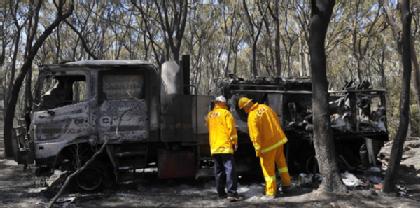 Ed: The charred shell of a $350,000 CFA truck near Belgrave Heights during the 2009 Victorian Bushfires.
Ed: The charred shell of a $350,000 CFA truck near Belgrave Heights during the 2009 Victorian Bushfires.The tanker was able to protect three firefighters from an out-of-control bushfire as it burnt over them.
But a decade before in 1998, a burn-over incident during a bushfire at Linton, near Ballarat, saw five CFA volunteers burned to death.
Unacceptable – volunteers, professional, completely unacceptable and unforgiveable. [Photo: Craig Abraham [courtesy: The Age 25-Feb-09]]
.
A report by ABC journalist, Jane Cowan, 1-Jul-09, ‘Bushfire lawyers blast CFA’s Rees’ states that lawyers assisting Brumby’s Royal Commission into the 2009 Victorian Bushfires have in an interim report concluded that the Victorian Country Fire Authority (CFA) was ill-prepared for Black Saturday.
The lawyers have criticised CFA chief fire officer, Russell Rees, as having been “divorced from fundamental aspects of the responsibilities” as chief officer, ‘including the provision of public warnings and the protection of life and assert that Mr Rees “should have made himself aware of predictions forecasting the path of the fires.”
Criticism has also been made about the reliance by the CFA on obsolete fire fighting technologies. Bushfire consultant assisting the Commission, Tony Cutcliffe, has stated “We still have people running these organisations who are predominantly devoted to a firefighting technology that is no longer in vogue let alone being attuned to the needs of behavioural management and leadership.”
What is most disturbing of all is that the CFA looks to continue business as usual. The CFA says it has full confidence in Mr Rees and expects him to be at the helm again this summer. Mr Cutcliffe has expressed his concerns that ‘whatever changes are made, as it stands now the same management team that presided over the system which failed to cope on Black Saturday will be required to implement the new regime.’
If the calamity of what happened to Victoria last summer won’t force an overhaul of firefighting in Australia, what will?
.
The CFA’s old-school firefighting culture dies hard:
- The CFA remains an emergency response organisation almost totally dependent on a disparate weekend volunteer base (not the fault of the volunteers who are effectively unpaid public servants)
- The CFA’s bushfire notification system is wholly reliant on public calls to 000
- The CFA’s fire fighting response system is centred around urban fire trucks that cannot access remote ignitions and so must wait until accessible from a roadside, when the fire is by then often out of control. Taking fire trucks into the bush to fight fires is deadly as the above photo shows
- The CFA remains a public authority with carte blanche to allow and deliberately cause immense irreversible damage to Victoria’s remaining ecolgical habitat, yet with no ecological expertise in its management or ranks
- The CFA is grossly underfunded by state and federal governments.
.
Timeless Systemic Questions:
1. Given that unprecedented extreme weather was forecast and known to the CFA, what commensurate planning, preparation and response did the CFA deploy and when?
2. What improvements in fire fighting practices have been implemented by the CFA since the 1983 Ash Wednesday fires to avoid a repeat?
3. Where are the statistics showing the fire fighting performance in respect to each reported ignition, namely:
a. Elapsed time from estimated ignition time to detection time (CFA becoming aware of ignition)
b. Elapsed time from detection time and on site response time (CFA arriving at the fire site/front with fire fighting equipment)
c. Elapsed time from response time to suppression time (fire extinguished by CFA)
.
These are the three core fire fighting performance metrics.
The Bushfire Royal Commission is following its terms of reference in assessing the specific facts and specific causes of the fires and logically as expected is starting to lay blame.
What’s the bet many findings are similar to those of previous bushfire investigations? If the Royal Commission finds that the current system and structure of Victoria’s (read Australia’s) volunteer firefighting organisation was at fault, then this is a constructive outcome.
Only at such a legal level will change be forced on the system and culture. Previous internal debrief meetings and investigations (e.g. the 2003 Esplin Enquiry) have managed to have lessons from bushfire disasters ignored and fire fighting practices remain relatively unchanged.
If fire fighting is becoming more effective then how can such tragedies be continuing and growing in scale? How much more 20-20 hindsight is needed by the so-called ‘experienced’ fire fighting leadership before we can observe tangible improvements in fire fighting performance?
Same old same old. Given the dire inadequacies of this organisation, the culture has forced to become one of absolute defeatism – the only way it believes it can deal with bushfires is to slash and burn as much of the natural burnable landscape as possible, so that there is nothing left to burn.
It’s as crackbrained as backburning through Belgrave Heights in order to save Belgrave.
Change cannot be brought to the CFA within the CFA. Change must come from Brumby and Rudd.>>
.


